tìm nghiệm trên khoảng (0;\(2\pi\)) của phương trình \(\frac{\left|sinx\right|}{sinx}=cosx-\frac{1}{2}\)
Hãy nhập câu hỏi của bạn vào đây, nếu là tài khoản VIP, bạn sẽ được ưu tiên trả lời.


Chọn A
Dựa vào bảng biến thiên ta thấy phương trình có 4 nghiệm phân biệt khi -3 < m < 2.

Đáp án A
Phương pháp giải:
Biến đổi công thức lượng giác, đưa phương trình bài cho về dạng phương trình cơ bản, kết hợp với điều kiện nghiệm để tìm giá trị của tham số m
Lời giải:
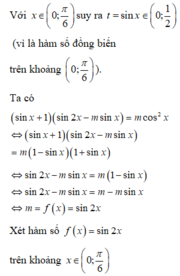
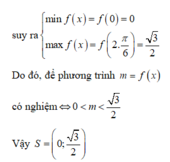

Đặt \(f\left(x,m\right)=\left(m^2+1\right)x^2+\left(2m+1\right)x-5\)
\(ycbt\Leftrightarrow\hept{\begin{cases}f\left(-1,m\right)\le0\\f\left(1,m\right)\le0\end{cases}}\Leftrightarrow\hept{\begin{cases}m^2-2m-5\le0\\m^2+2m-3\le0\end{cases}}\Leftrightarrow\hept{\begin{cases}1-\sqrt{6}\le m\le1+\sqrt{6}\\-3\le m\le1\end{cases}}\)
\(\Leftrightarrow1-\sqrt{6}\le m\le1\)
Đặt ƒ (x,m)=(m2+1)x2+(2m+1)x−5
ycbt⇔{
| ƒ (−1,m)≤0 |
| ƒ (1,m)≤0 |
⇔{
| m2−2m−5≤0 |
| m2+2m−3≤0 |
⇔{
| 1−√6≤m≤1+√6 |
| −3≤m≤1 |
⇔1−√6≤m≤1

1.
\(cos2x-3cosx+2=0\)
\(\Leftrightarrow2cos^2x-3cosx+1=0\)
\(\Leftrightarrow\left[{}\begin{matrix}cosx=1\\cosx=\dfrac{1}{2}\end{matrix}\right.\)
\(\Leftrightarrow\left[{}\begin{matrix}x=k2\pi\\x=\pm\dfrac{\pi}{3}+k2\pi\end{matrix}\right.\)
\(x=k2\pi\in\left[\dfrac{\pi}{4};\dfrac{7\pi}{4}\right]\Rightarrow\) không có nghiệm x thuộc đoạn
\(x=\pm\dfrac{\pi}{3}+k2\pi\in\left[\dfrac{\pi}{4};\dfrac{7\pi}{4}\right]\Rightarrow x_1=\dfrac{\pi}{3};x_2=\dfrac{5\pi}{3}\)
\(\Rightarrow P=x_1.x_2=\dfrac{5\pi^2}{9}\)
2.
\(pt\Leftrightarrow\left(cos3x-m+2\right)\left(2cos3x-1\right)=0\)
\(\Leftrightarrow\left[{}\begin{matrix}cos3x=\dfrac{1}{2}\left(1\right)\\cos3x=m-2\left(2\right)\end{matrix}\right.\)
\(\left(1\right)\Leftrightarrow x=\pm\dfrac{\pi}{9}+\dfrac{k2\pi}{3}\)
Ta có: \(x=\pm\dfrac{\pi}{9}+\dfrac{k2\pi}{3}\in\left(-\dfrac{\pi}{6};\dfrac{\pi}{3}\right)\Rightarrow x=\pm\dfrac{\pi}{9}\)
Yêu cầu bài toán thỏa mãn khi \(\left(2\right)\) có nghiệm duy nhất thuộc \(\left(-\dfrac{\pi}{6};\dfrac{\pi}{3}\right)\)
\(\Leftrightarrow\left[{}\begin{matrix}m-2=0\\m-2=1\\m-2=-1\end{matrix}\right.\Leftrightarrow\left[{}\begin{matrix}m=2\\m=3\\m=1\end{matrix}\right.\)
TH1: \(m=2\)
\(\left(2\right)\Leftrightarrow cos3x=0\Leftrightarrow x=\dfrac{\pi}{6}+\dfrac{k2\pi}{3}\in\left(-\dfrac{\pi}{6};\dfrac{\pi}{3}\right)\Rightarrow x=\dfrac{\pi}{6}\left(tm\right)\)
\(\Rightarrow m=2\) thỏa mãn yêu cầu bài toán
TH2: \(m=3\)
\(\left(2\right)\Leftrightarrow cos3x=0\Leftrightarrow x=\dfrac{k2\pi}{3}\in\left(-\dfrac{\pi}{6};\dfrac{\pi}{3}\right)\Rightarrow x=0\left(tm\right)\)
\(\Rightarrow m=3\) thỏa mãn yêu cầu bài toán
TH3: \(m=1\)
\(\left(2\right)\Leftrightarrow cos3x=-1\Leftrightarrow x=\dfrac{\pi}{3}+\dfrac{k2\pi}{3}\in\left(-\dfrac{\pi}{6};\dfrac{\pi}{3}\right)\Rightarrow\left[{}\begin{matrix}x=\pm\dfrac{1}{3}\\x=-1\\x=-\dfrac{5}{3}\end{matrix}\right.\)
\(\Rightarrow m=2\) không thỏa mãn yêu cầu bài toán
Vậy \(m=2;m=3\)
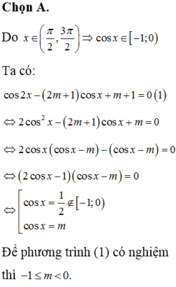

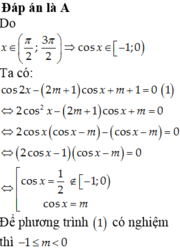

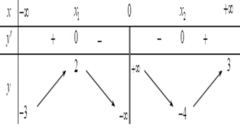


- Với \(0< x< \pi\) \(\Rightarrow sinx>0\)
Pt trở thành: \(\frac{sinx}{sinx}=cosx-\frac{1}{2}\Leftrightarrow cosx=\frac{3}{2}>1\) (vô nghiệm)
- Với \(\pi< x< 2\pi\Rightarrow sinx< 0\)
Pt trở thành:
\(\frac{-sinx}{sinx}=cosx-\frac{1}{2}\Leftrightarrow cosx=-\frac{1}{2}\)
\(\Rightarrow x=\frac{4\pi}{3}\)